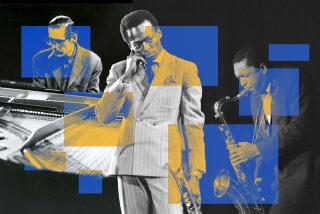Tribute and Tendency
Pianists who are primarily soloists or small-group leaders often tend to write music that is, not surprisingly, pianistic in character. Unlike, say, Duke Ellington, who always seemed to compose from an orchestral point of view, solo-oriented players generally seem to produce music framed by both the expansiveness and the limitations of their keyboard instruments.
There are exceptions, of course, such as Thelonious Monk, whose compositions, despite their pianistic origins, transcend the instrument and find lives of their own. But the works of other pianists--Bud Powell comes to mind--remain linked, despite their attractiveness as compositions, to their origins in the piano.
The musical careers of Bill Evans and Michel Petrucciani were built, first of all, upon a foundation of superb instrumental skills. But each has revealed--Evans, in particular--some first-rate compositional abilities as well. Works such as “Waltz for Debby,” “Peace Piece” and “Epilogue” have enough substance to attract the attention of numerous other artists.
Arranger Don Sebesky, whose resume ranges from Tommy Dorsey and Maynard Ferguson to Freddie Hubbard and Sonny Stitt, is a longtime Evans fan. “Rarely a day goes by without my feeling [his] influence,” Sebesky says.
His tribute includes thoughtful orchestral interpretations of six Evans works. Sebesky wisely recognizes, however, that composition can take place in many fashions. And Evans, who died in 1980 at the age of 51, also composed when he was playing familiar tunes, transforming harmonies and rhythms to bring the music into entirely new perspectives. Sebesky’s program includes arrangements of three standards often played by Evans--”Autumn Leaves,” “All the Things You Are” and “I’m Getting Sentimental Over You”--in which the pianist’s subtle harmonic voicings are rendered by appropriate instrumental combinations.
The orchestrations range across a sonorous group of ensembles, sometimes rich with brass and woodwinds, at other times spare and to the point. Adding substance and energy to an already well-fashioned set of pieces is an unusually high-level lineup of soloists, among them, fluegelhornist Tom Harrell, alto saxophonist Lee Konitz, tenor saxophonist Joe Lovano, clarinetist Eddie Daniels, guitarist Larry Coryell, singer-guitarist Johnny Pizzarelli and the vocal quartet New York Voices.
As a bonus, there is an interview with Evans, conducted by jazz disc jockey Willis Conover in 1973, in which the pianist makes a comment perfectly defining both the modesty and the adventurousness of his creative overview:
“I wasn’t striving to be an identifiable stylist,” he says. “I was really only striving to make music and to put it together in some way of my own.”
The Petrucciani album differs, first in the fact that the composer is present to hear and participate in the lighthearted arrangements of his work written by trombonist Bob Brookmeyer. But it also differs in the sense that Petrucciani’s works register most strongly as pianistic lines transcribed for an instrumental ensemble.
A few of the tunes manage to transcend the heavy harmonies and fleet melodies at the heart of Petrucciani’s works--the floating theme of “Guadeloupe” is one. Most of the pieces, however, move quickly through the ensemble passages into the soloing. Nothing wrong with that, given Petrucciani’s presence, playing at the top of his form, and the surprisingly strong horn soloing from saxophonist Stefano Di Battista and trumpeter Flavio Boltro.
But the focus is clearly affected by Petrucciani’s tendency to think as a player rather than as a composer and by the characteristically swing-oriented style of Brookmeyer’s orchestrations. Unlike the Sebesky-Evans album, this is less an effort to explore the compositional potential in Petrucciani’s music than it is a demonstration of the diminutive French pianist’s capacity to create music that triggers imaginative improvisation.
And it is Petrucciani’s ever-compelling talents as a soloist, made more fascinating in the context of his own compositions, that makes this such an appealing outing.
*
Albums are rated on a scale of one star (poor), two stars (fair), three stars (good), four stars (excellent).
More to Read
The biggest entertainment stories
Get our big stories about Hollywood, film, television, music, arts, culture and more right in your inbox as soon as they publish.
You may occasionally receive promotional content from the Los Angeles Times.










